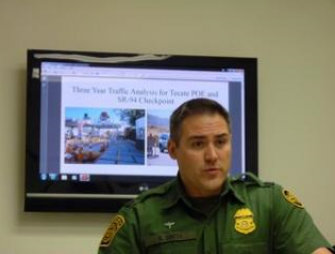
By Miriam Raftery
February 8, 2016 (San Diego’s East County) – Motorists on State Route 94 report longer commutes in recent months due to delays at the Otay Border Patrol checkpoint south of Jamul, as well as construction of a casino at the Jamul Indian Village and existing delays due to Steele Canyon High School traffic.
“Since April, the lines at the checkpoint have been consistently long and wait times longer,” Jan Hedlun, a Potrero resident who commutes to work in San Diego, wrote to the Border Patrol last September. She described backups of over two miles at the checkpoint at times, with waits of nearly a half hour.
“This is unacceptable,” she added. “we are speaking about lost wages for a large number of people and the possible loss of jobs for other.”
East County Magazine attended a meeting at the Border Patrol station last fall, along with concerned community members.
The meeting began with a slide show presentation and an explanation of how Border Patrol officers’ responsibilities have changed since its inception back in 1924. Today, the Border Patrol is part of Customs and Border Protection (CBP) under the Department of Homeland Security (DHS). The San Diego division is responsible for patroll
ing 7,000 land miles and 2,000 coastal miles, all the way up to Oregon. They operate eight checkpoint stations.
After the 9/11 terrorism attacks, DHS was created. Money and manpower doubled. In 2012, the focus shifted, with a number one goal to prevent terrorists and weapons from entering the U.S. Locally, three people on the terrorist watch list have been apprehended, says public information officer Jose Hernandez. The Border Patrol has also nabbed increasingly innovative smugglers using high-tech tunnels, ultralights, and Ponga rafts. The CPB operates a search and rescue team, a SWAT team, agents on all-terrain vehicles and horses to fulfill their mission.
“We have a huge mission. I think it’s an honorable missing, and it’s a challenging mission,” said Agent Boone Smith. He points to tough conditions for agents working in 120 degree heat with “boots melting,” adding, “I used to see a dead body probably every week.”
But there’s a big problem—and it’s contributing to the traffic snarls. “Unfunded mandates require 100% outbound inspections. They should double our budget,” notes Smith. He thanked residents for raising the problem, adding, “If we don’t know about it, we can’t fix it….the notice you give us regarding traffic backup is legitimate. I don’t want to see the community having to get up a half hour earlier, or an hour earlier.”
He admits that attaining 100% border security is “impossible. Some say `100% of the time, the checkpoint will be up and citizens be damned.’” He disagrees with that harsh assessment, but explains that solving the problem poses challenges of its own.
Traffic has gone up. The Tecate Point of entry in 2013 had 861,433 vehicles inspected. By 2015, that number rose to 1.4 million. At Tecate, lanes were added to help with that increase. But that’s impossible at the Otay checkpoint due to constraints of the terrain and environmental issues.
Traffic at the Otay checkpoint on 94 went up just 6% from 2013 to 2015, from about 1.1 million to just under 1.2 million vehicles. Apprehensions also rose 5 to 10% during the same time.
But even a small increase in traffic can cause problems on 94, which has curves. Backing up traffic around blind curves puts drivers at risk, and Smith observes, “We are not willing to risk public safety.” At other checkpoints, such as on I-8, backups can better be handled along a straight stretch of highway.
“There were 136,786 more crossings (at Otay) than at the Tecate point of entry. We have fewer inspection lanes and we’re doing more traffic here at Otay,” Smith said.
The peak traffic at Otay is between 5 a.m. and 10 a.m., with 254 vehicles per hour coming through the checkpoint.
So why not just add more lanes? That would require pouring concrete in a watershed. “We can’t grade or augment that, plus there is no money,” Boone stated. “We have a limited footprint, so we can’t expand.” Space is so limited that agents can’t even wash vehicles on site, he added.
Over a decade ago, the Border Patrol tried issuing stickers to frequent commuters that allowed them to be waved through. But after a while, smugglers learned to counterfeit the passes, so the stickers were discontinued.
It’s not just smugglers caught at the checkpoint. Now equipped with license plate readers, the checkpoints catch “hundreds of rapists, child molesters, all kinds of people,” Smith notes.
Checkpoints are sometimes shut down for safety’s sake, such as during rainstorms. “We listen to you,” Smith insisted, though residents afterwards voiced frustration that little progress seemed to have been made.
Hedlun also voiced concern over agents using one of the two highway lanes as a secondary inspection site. “That’s dangerous to all of us,” she said. “If an incident occurred, people in line can’t go anywhere…in most areas, secondary is set farther back from the people.”
One of the agents responded that they would love to have a secondary inspection lane, but that there is “no where to put it.”
Another resident present asked why the Border Patrol doesn’t use technology to track how far traffic is backed up every minute of the day, and take steps to wave vehicles through if the delay is becoming too long or too dangerous.
Hedlun said her community plans to invite Border Patrol out to further address concerns about checkpoint delays, particularly with the prospect of added traffic on highway 94 once a new casino opens, as well as high school traffic. In addition, dips in the roadway due to storm drains not cleared out also recently caused flooding that caused further delays and headaches for motorists.
In an e-mail signed “frustrated resident,” Hedlun asked, “What plans are in place to fix ALL of this?”










Comments
Checkpoint Delays
Checkpoint Delays on Highway 94